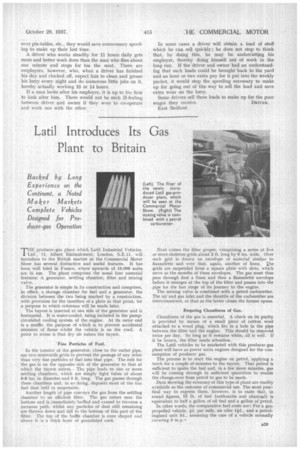Latil Introduces Its Gas Plant to Britain
Page 141

If you've noticed an error in this article please click here to report it so we can fix it.
Backed by Long Experience on the Continent, a Noted Maker Markets C ornplet e Vehicles Designed for Producer-gas Operation THE producer-gas plant which Latil Industrial Vehicles. Ltd., 11, Albert Embankment, London, S.E.1I, will introduce to the British market at the Commercial Motor Show has several distinctive and useful features. It has been well tried in France, where upwards of 10,000 units are in use. The plant comprises the usual four essential features: A generator, settling chamber, filter and mixing valve.
The generator is simple in its construction and comprises, in effect, a storage chamber for fuel and a generator, the division between the two being marked by a constriction, with provision for the insertion of a plate at that point, for a purpose to which reference will be made later.
The tuyere is inserted at one side of the generator and is horizontal, It is water-cooled, being included in the pumpcirculated cooling system of the engine. At its outer end is a muffle, the purpose of which is to prevent accidental emission of flame whilst the vehicle is on the road. A point to stress is that dry air enters the tuyere.
-Fine Particles of Fuel.
In the interior of the generator, close to the outlet pipe, are two removable grids to pretreat the passage of any other than very fine particles of fuel into that pipe. The exit for the gas-is on the opposite side of the generator to that at which the tayere enters., The pipe leads to one or more settling chambers, which are simply light tubes of about 6-8 ins, in diameter and 5 ft. long. The gas passes through these chambers and, in so doing, deposits most of the fine fuel dust held in suspension.
Another length of pipe conveys the gas from the settling chamber to an efficient filter. The gas enters near the bottom and is immediately baffled and caused to traverse a tortuous path. Whilst any particles of dust still remaining are thrown down and fall to the bottom of this part of the filter. The top of the baffle chamber is cone shaped and above it is a thick layer of granulated cork.
Next comes the filter proper, comprising a series of five or more skeleton grids about 2 ft. long by 9 ins. wide. Over each grid is drawn an envelope of material similar to flannelette and over that, again, another of linen. The grids are suspended from a square plate with slots, which serve as the months of these envelopes. The gas must thus pass through first a linen and then a flannelette envelope before it emerges at the top of the filter and passes into the pipe for the last stage of its journey to the engine.
The mixing valve is combined with a petrol carburetter. The air and gas inlet_and the throttle of the carburetter arc interconnected, so that as the latter closes the former opens.
Enuring Cleanliness of Gas.
Cleanliness of the gas is essential. A check on its purity is provided by means of a small piece of cotton wool attached to a wood plug, which fits in a hole in the pipe between the-filter and the engine. This should be removed twice per day. So long as it remains white, all is well. If it be brown, the filter needs attention.
The Lath vehicles to be marketed with this producer-gas plant will have as power units engines designed for the consumption of producer gas.
The process is to start the engine on petrol, applying a torch for a couple of -minutes to the tuyere. That period is sufficient to ignite the fuel and, in a few more minutes, gas will be coming through in sufficient quantities to enable the change-over from petrol to gas to be made.
Data showing the economy of this type of plant are readily available as the outcome of commercial use. The most practical way to express them, however, is to state that, in round figures, 15 lb. of fuel (anthracite and charcoal) is equivalent to half a gallon of oil fuel and a gallon of petrol.
In other words, the comparative fuel costs are : For a gaspropelled vehicle, id. per mile, an oiler lid., and a petrolengmed unit 3d., assuming the case of a vehicle normally covering S
























































































































































































